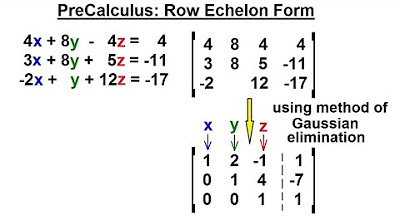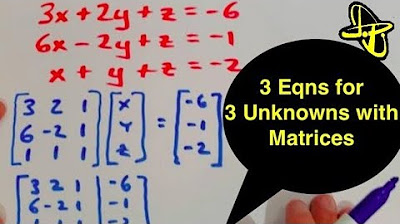PreCalculus - Matrices & Matrix Applications (6 of 33) Method of Gaussian Elimination: 2x2 Matrix
TLDRThe video script presents a step-by-step guide on solving a system of linear equations using the method of Gaussian elimination. It demonstrates the process with a 2x2 matrix, explaining how to manipulate the matrix to achieve a diagonal of ones and zeros elsewhere. The technique is then applied to find the values of the variables X and Y. The video emphasizes the efficiency of this method for more complex systems with multiple equations and unknowns, highlighting its practicality beyond simple cases.
Takeaways
- 📚 The lecture introduces the method of Gaussian elimination for solving systems of linear equations with two variables (X and Y).
- 🔢 The process starts with an augmented 2x2 matrix, representing the coefficients of the variables and the constants from the equations.
- 🎨 The first step in Gaussian elimination is to transform the first entry into a '1' by dividing the first row by its coefficient.
- 🔄 To eliminate the variable entry in the second row, the first row is multiplied by the negative reciprocal and added to the second row.
- 📉 The resulting matrix after the first elimination step should have a '0' in the second entry of the first row.
- 🔢 Continuing the process, the second entry in the second row is targeted to become '1' by multiplying the entire row by its reciprocal.
- 🔄 The first row is again modified, using the newly created '1' in the second row, to turn the second entry of the first row into '0'.
- 📊 The final matrix should have a '1' in the diagonal with '0's in the other entries of the row and column representing the variable.
- 👤 The values of X and Y can be directly read from the last column of the matrix, representing the solutions to the system of equations.
- 📈 Gaussian elimination is particularly useful for larger systems of equations, making it easier to manage compared to traditional algebraic methods.
- 🚀 The lecture concludes by预告ing the next topic, which will apply the Gaussian elimination method to a more complex 3x3 system of equations.
Q & A
What is the main topic of the lecture?
-The main topic of the lecture is solving systems of linear equations using the method of Gaussian elimination.
How many equations and unknowns are being discussed in the lecture?
-The lecture initially discusses a system with two equations and two unknowns, X and Y, and later mentions a system with three equations and three unknowns.
What is an augmented matrix?
-An augmented matrix is a matrix that includes both the coefficients of the variables and the constants from the system of linear equations, allowing for easier manipulation during the process of elimination.
What is the first step in using Gaussian elimination?
-The first step is to rewrite the system of equations in matrix form and ensure that the augmented matrix has ones on the diagonal, and zeros elsewhere.
How is the first variable (X) solved for in the given example?
-The first variable (X) is solved for by manipulating the matrix to have a 1 in the diagonal position corresponding to X, and then interpreting the resulting column below the 1 as the value of X.
What is the role of the second variable (Y) in the system?
-The role of the second variable (Y) is to be part of the system of equations. In the given example, once X is determined, the value of Y is found by looking at the second column and the value in the diagonal position, which, when multiplied by 1 (the value in the diagonal), gives the value of Y.
Why is Gaussian elimination useful for solving systems of linear equations?
-Gaussian elimination is useful because it simplifies the process of solving systems with multiple equations and unknowns, making it easier to find solutions compared to other algebraic methods.
What happens to the second row when the first row is divided by 2?
-When the first row is divided by 2, the second row remains unchanged as it is not involved in the operation.
How are zeros obtained in the matrix during Gaussian elimination?
-Zeros are obtained by performing row operations, such as multiplying a row by a negative number and adding it to another row, to eliminate non-diagonal coefficients.
What is the final result of the example provided in the script?
-The final result of the example is the solution to the system of equations, which is x = 2 and y = 1.
What is the significance of the method of Gaussian elimination in solving more complex systems?
-The method of Gaussian elimination becomes particularly useful and efficient when solving more complex systems with multiple equations and unknowns, as it simplifies the process and reduces the potential for errors.
Outlines
📚 Introduction to Solving Systems of Linear Equations
This paragraph introduces the topic of solving a system of linear equations with two variables, X and Y, using the method of Gaussian elimination. It explains the initial setup with two equations and two unknowns, and the use of a 2x2 augmented matrix to represent the system. The speaker begins the process by normalizing the first row to have a coefficient of 1 in the first position, followed by a series of row operations to eliminate variables and simplify the matrix. The goal is to achieve a diagonal of ones and zeros elsewhere, leading to the solution of the variables' values. The paragraph emphasizes the practicality of learning Gaussian elimination for solving more complex systems of equations.
Mindmap
Keywords
💡linear equations
💡Gaussian elimination
💡augmented matrix
💡row operations
💡diagonal
💡system of equations
💡coefficients
💡constants
💡variable
💡upper triangular matrix
💡back-substitution
Highlights
Introduction to solving a system of linear equations with two variables X and Y.
Use of the method of Gaussian elimination with a 2x2 matrix or an augmented 2x2 matrix.
Rewriting the system in matrix format by taking coefficients and augmenting with constants.
Dividing the first row by two to get a one on the diagonal.
Elimination of the three in the second row by using row operations.
Transforming the second row into a row with a one by multiplying by -2/13.
Elimination of the -3/2 in the first row by adding a multiple of the second row.
Resulting matrix with a zero in the first row and one in the second, simplifying to x=2 and y=1.
Explanation of the practicality of Gaussian elimination for more complex systems of equations.
Advantages of Gaussian elimination over algebraic methods for larger systems of equations.
Introduction to solving a 3x3 system of linear equations in the next session.
Use of the method of Gaussian elimination for 3x3 systems to solve systems of linear equations.
Explanation of the process of turning the first entry into a one and the second entry into a zero through row operations.
Detailed step-by-step guide on how to perform Gaussian elimination on a 2x2 matrix.
Demonstration of how to achieve a diagonal of ones and zeros elsewhere through Gaussian elimination.
The transition from a complex matrix to a simplified form that reveals the values of X and Y.
The significance of the method of Gaussian elimination in solving more complex systems efficiently.
Transcripts
Browse More Related Video

PreCalculus - Matrices & Matrix Applications (10 of 33) Gaussian Elimination: Example of Solving 3x3

PreCalculus - Matrices & Matrix Applications (7 of 33) Method of Gaussian Elimination: 3x3 Matrix*

PreCalculus - Matrices & Matrix Applications (5 of 33) Method of Gaussian Elimination: Example

PreCalculus - Matrices & Matrix Applications (3 of 33) Row Echelon Form

Gaussian Elimination & Row Echelon Form

Solving 3 Equations for 3 Unknowns Using a Matrix in Row Echelon Form
5.0 / 5 (0 votes)
Thanks for rating: